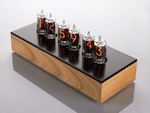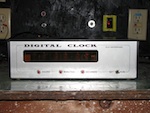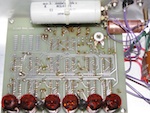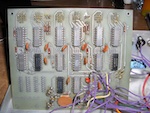By Adam Vaughn


In recent years, there has been increased interest in building clocks using Nixie tubes. Glass bottles filled with neon gas and containing various wire cathodes shaped like numbers, Nixie tubes (developed by Burroughs Corp. in 1955) were used in test equipment and early digital devices (including clocks) from the 1950s into the 1970s. Alternatives included the Numitron (seven segment incandescent filament devices) and vacuum fluorescent displays (which continue to be used in some devices today). Eventually, they were eclipsed by low-power display technologies like LED and LCD, and faded into obscurity.
However, in the late 1990s, electronics experimenters rediscovered them, and began employing them in new designs using modern technology. Microcontrollers and surface-mount technology were increasingly used to make complex clocks with more features. Time synchronization started to be done using exotic methods such as GPS and atomic clock radio control. US and European Nixie tubes gave way to ones produced in the former Soviet Union well into the 1980s as stocks of old-production tubes ran low. Novelty designs appeared, using extremely large or extremely small Nixie tubes (a few people have even offered them within wristwatches!). Most of these new designs employed an open layout, placing the tubes either within a clear enclosure, or sticking out through holes from a fancy wood/metal box, occasionally lit from underneath using LEDs. Some examples of modern designs (along with some older-style ones) can be seen on this page. A typical example can be seen below:

However, they weren't always like this. The earliest Nixie clocks used electromechanical means (such as stepping switches) to increment the digits, but these were complicated to build, not to mention expensive parts-wise. Then, in the late 1960s and early 1970s, hobbyists began experimenting with then-new digital technology (such as 7400-series TTL ICs) as it became more generally affordable. For a brief period of time, Nixie tubes became popular as readout displays in their early digital projects, just before LEDs took over. Here is an example of a Nixie tube clock built when they were still current technology:

I bought this clock at a flea market several years ago. It was sold as a kit by a company called B&F Enterprises, based in Massachusetts, around 1972. They offered deals on Nixie tubes, Numitrons, semiconductors, and other electronic components. At some point, they started selling these digital clock kits for a reasonable price (relatively speaking, anyway; they weren't exactly cheap!). Here is a photo of it in action:

As you can see, it makes no attempt to show off the method used to produce the digits, only that it is (as the front panel boasts) a "DIGITAL CLOCK". The case is thin metal, and the circuitry is completely enclosed. The Nixie tubes themselves are purposely obscured behind a tinted plastic window. Most interestingly, it offers adjustment buttons for hours, minutes and seconds, along with a momentary SET/RUN switch (which also holds the seconds count), all on the front panel.

Inside, we have a double-sided PC board, with the component side facing downwards, and the Nixie tubes soldered to what would normally be the bottom of the board. The tubes themselves are Amperex "ZM1000R" types, which have a reddish-orange coating on the outside. The colons in between the digit sets are long neon lamps with bands over portions of it.

All of the chips on the component side are 7400 series TTL ICs. Many of these ICs were replaced in the mid-late 1980s, judging by the date codes present on them, though some of them are 1972 originals. I find it amazing that someone (the original builder?) attempted to keep it running well into the LED era. Even today, many TTL ICs are still readily available, even in old-fashioned Dual Inline Package (DIP) form.
To me, it's fascinating to compare this digital clock to modern types made nowadays. When it was built, the novelty wasn't that it was a Nixie tube clock, but that it used an electronic-digital display rather than an analog or mechanical-digital type. This was during the era when calculators were approaching pocket size, and digital wristwatches (using tiny LED displays) were first appearing in the marketplace (and still extremely expensive). Nixie tubes may be "retro-chic" nowadays, but when this was made, they were still state-of-the-art.
Site Navigation:
Back to the clock page!
Go to the main page!
